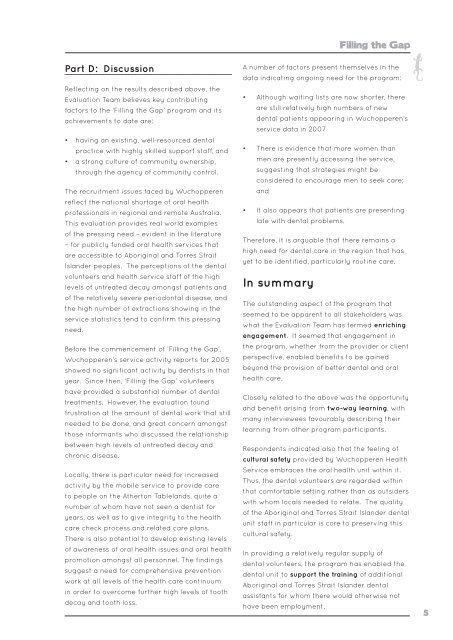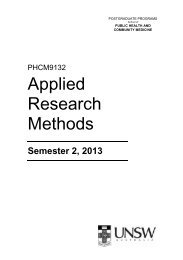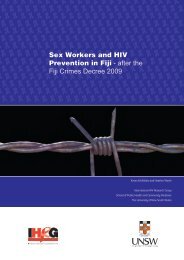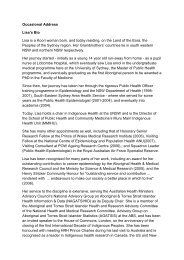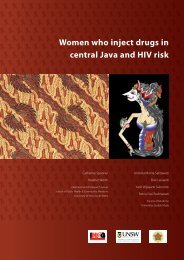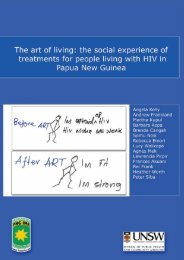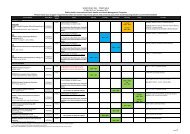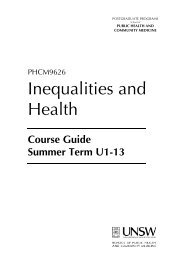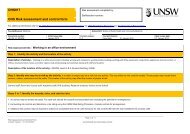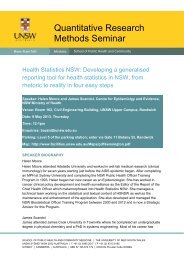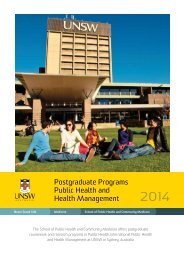Word of Mouth - School of Public Health and Community Medicine ...
Word of Mouth - School of Public Health and Community Medicine ...
Word of Mouth - School of Public Health and Community Medicine ...
- No tags were found...
You also want an ePaper? Increase the reach of your titles
YUMPU automatically turns print PDFs into web optimized ePapers that Google loves.
Filling the GapPart D: DiscussionReflecting on the results described above, theEvaluation Team believes key contributingfactors to the ‘Filling the Gap’ program <strong>and</strong> itsachievements to date are:• having an existing, well-resourced dentalpractice with highly skilled support staff, <strong>and</strong>• a strong culture <strong>of</strong> community ownership,through the agency <strong>of</strong> community control.The recruitment issues faced by Wuchopperenreflect the national shortage <strong>of</strong> oral healthpr<strong>of</strong>essionals in regional <strong>and</strong> remote Australia.This evaluation provides real world examples<strong>of</strong> the pressing need – evident in the literature– for publicly funded oral health services thatare accessible to Aboriginal <strong>and</strong> Torres StraitIsl<strong>and</strong>er peoples. The perceptions <strong>of</strong> the dentalvolunteers <strong>and</strong> health service staff <strong>of</strong> the highlevels <strong>of</strong> untreated decay amongst patients <strong>and</strong><strong>of</strong> the relatively severe periodontal disease, <strong>and</strong>the high number <strong>of</strong> extractions showing in theservice statistics tend to confirm this pressingneed.Before the commencement <strong>of</strong> ‘Filling the Gap’,Wuchopperen’s service activity reports for 2005showed no significant activity by dentists in thatyear. Since then, ‘Filling the Gap’ volunteershave provided a substantial number <strong>of</strong> dentaltreatments. However, the evaluation foundfrustration at the amount <strong>of</strong> dental work that stillneeded to be done, <strong>and</strong> great concern amongstthose informants who discussed the relationshipbetween high levels <strong>of</strong> untreated decay <strong>and</strong>chronic disease.Locally, there is particular need for increasedactivity by the mobile service to provide careto people on the Atherton Tablel<strong>and</strong>s, quite anumber <strong>of</strong> whom have not seen a dentist foryears, as well as to give integrity to the healthcare check process <strong>and</strong> related care plans.There is also potential to develop existing levels<strong>of</strong> awareness <strong>of</strong> oral health issues <strong>and</strong> oral healthpromotion amongst all personnel. The findingssuggest a need for comprehensive preventionwork at all levels <strong>of</strong> the health care continuumin order to overcome further high levels <strong>of</strong> toothdecay <strong>and</strong> tooth loss.A number <strong>of</strong> factors present themselves in thedata indicating ongoing need for the program:• Although waiting lists are now shorter, thereare still relatively high numbers <strong>of</strong> newdental patients appearing in Wuchopperen’sservice data in 2007• There is evidence that more women thanmen are presently accessing the service,suggesting that strategies might beconsidered to encourage men to seek care;<strong>and</strong>• It also appears that patients are presentinglate with dental problems.Therefore, it is arguable that there remains ahigh need for dental care in the region that hasyet to be identified, particularly routine care.In summaryThe outst<strong>and</strong>ing aspect <strong>of</strong> the program thatseemed to be apparent to all stakeholders waswhat the Evaluation Team has termed enrichingengagement. It seemed that engagement inthe program, whether from the provider or clientperspective, enabled benefits to be gainedbeyond the provision <strong>of</strong> better dental <strong>and</strong> oralhealth care.Closely related to the above was the opportunity<strong>and</strong> benefit arising from two-way learning, withmany interviewees favourably describing theirlearning from other program participants.Respondents indicated also that the feeling <strong>of</strong>cultural safety provided by Wuchopperen <strong>Health</strong>Service embraces the oral health unit within it.Thus, the dental volunteers are regarded withinthat comfortable setting rather than as outsiderswith whom locals needed to relate. The quality<strong>of</strong> the Aboriginal <strong>and</strong> Torres Strait Isl<strong>and</strong>er dentalunit staff in particular is core to preserving thiscultural safety.In providing a relatively regular supply <strong>of</strong>dental volunteers, the program has enabled thedental unit to support the training <strong>of</strong> additionalAboriginal <strong>and</strong> Torres Strait Isl<strong>and</strong>er dentalassistants for whom there would otherwise nothave been employment.5


